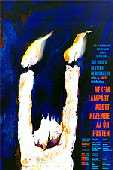 |
Vol 1, No 2, 5 July 1999
|
|
|
 K I N O E Y E :
K I N O E Y E :Hamlet in Wonderland Miklos Jancso's Nekem lampast adott kezembe az Ur Pesten Andrew J Horton Miklos Jancso is possibly the most famous and most highly regarded Hungarian director of all time. His reputation rests on a body of work which makes high intellectual demands of its audience and provokes awkward questions without trying to answer them. After a long period in the doldrums, Miklos Jancso has re-emerged with Nekem lampast adott kezembe az Ur Pesten (The Lord's Lantern in Budapest, 1998), a blackly humorous look at the post-1989 culture of violence that won him the Gene Moskovitz prize from international critics at the Hungarian Film Week in Budapest earlier this year. The reception was a mixed one, however, with the Hungarian pre-selection judges for the festival eliminating the film from the competition whilst pushing through what could charitably called masterpieces of the Hungarian new wave of unintented kitsch. They cannot be totally blamed, however. Nekem lampast is almost impenetrably dense in its richness and lacks a plot in any meaningful sense of the term. To understand why it is a masterpiece, the film must be seen in the context of Jancso's career. Spotty career Jancso, like so many directors of the classic period of Hungarian film, began by making documentaries in the early 1950s. In 1958, he turned to feature films, and his first masterpiece, Igy jottem (My Way Home) was made in 1964. A string of internationally acclaimed works followed, including Szegenylegenyek (The Round-up) in 1965, Fenyes szelek (Confrontation, 1968) and Meg ker a nep (Red Psalm) in 1971, for which he was awarded at Cannes as best director the following year.His approach has always been intelligent and experimental. In fact, sometimes too intelligent and too experimental, as several of his films are so elliptical to lose all but the most dedicated Jancso fans. Although a committed Marxist, Jancso's mature work remained independent of the Party line and several of his works - notably Szegenylegenyek - can be read as highly critical of Communism as it was practised in Hungary. After the highly productive years of the 60s, Jancso's career floundered. Although a profoundly Hungarian artist, he decided to work on several projects in Italy in the 70s and 80s and these noticeably lack the impact of the works made in his home country. However, his career in this period was diverse, covering historical feature films, a documentary of a Hungarian rock group, a Faustian television series and much work in the theatre. With the fall of Communism in 1989, Jancso has been in an interesting position in cinema. Ever inquiring and critical, and still retaining his Socialist beliefs, he has become a sceptical observer of post-Communist society. Kek Duna keringo (Blue Danube Waltz, 1991) is a characteristically bleak look at Hungary's emerging political scene. However, his films still failed to conjure up the magic, and the critical attention, of his works of the 60s. His latest film, Nekem lampast adott kezembe az Ur Pesten (literally "The Lord Put a Lantern in My Hand in Pest" but marketed as the snappier The Lord's Lantern in Budapest for English-speakers), again sees him questioning contemporary Hungarian culture. He also continues on from his previous work by employing two significant and long-standing collaborators: the novelist Gyula Hernadi, who has been writing screenplays for Jancso since Igy jottem, and Ferenc Grunwalsky as director of photography. (Grunwalsky incidentally is a director in his own right [click here for Kinoeye's review of his latest film which contrasts with Jancso's]) Man as pet The central characters of Nekem lampast are Pepe and Kapa, two grave-diggers in a Pest cemetery, and Zsolt, some sort of mafia business man who likes to hang out there for no obvious reason. However, in this film nothing can be certain: Pepe is also a policeman who is about to arrest Kapa for drinking behind the wheel of his car to calm himself after he discovers his entire family has been wiped out by his niece, and Zsolt is his wife's favourite doctor. Kapa is a multi-billionaire trying to buy Budapest's parliament building and the castle, who tries to talk Pepe out of taking a suicide leap from the Chain Bridge. Additionally, Pepe is a cleaner and Kapa a tattooed mafia mobster.
Starting with the words "If I were an animal, I wouldn't keep a man as a pet," Jancso's work is a sharply acted film of cynical asides and black one-liners, but with no discernible plot-line in the conventional sense of the term. However, strong performances and perfect timing by Zoltan Mucsi and Peter Scherer make the film as enjoyable and dynamic as it is morbid, although the pace does fall off towards the end of the film. Jancso introduces us to a world in which money and violence are everything and nothing. The gun rules supreme, but its effects are meaningless, as characters are repeatedly killed and then resurrected without explanation. The characters live numbed in a world that is insulated from the true meaning of the violence which surrounds them: Pepe has never even heard of Adolf Hitler and during one scene of violence, the hysterical screaming of young women is brought to a neat crescendo by Zsolt, who acts as an impromptu choirmaster. Not to mention the casual air with which characters kill off their nearest and dearest. The world is a purely cinematic one and the characters are constantly intrigued by the screen and its limits. They cannot see other characters standing next to them because they are off-screen and objects thrown into the action from outside of the frame materialise for them as if from nowhere. A Shakespearean looking glass The characters also question their own existence, whether it is through contemplation of suicide or by questioning why it is that they are still alive even though they have been killed. Furthermore, the principal roles of the two main characters as grave-diggers sets up obvious Shakespearean allusions. However, the metaphysical questions Pepe and Kapa ask themselves and each other remain unanswered. Ultimately, their futile existential enquiries are merely bad imitations of even the most basic analytical thought, to say nothing of the rich musings of the Bard. The mocking publicity for Nekem lampast urges the viewer to live their life and be content without questioning it. Jancso, of course, has never produced a film which has not attempted to do exactly the opposite. Nekem lampast is an attack on the complacency of present-day Hungarian society, a culture which is itself obsessed with violence but cannot comprehend its consequences, does not care to and only half-heartedly questions its surroundings. For all the "through the looking glass" type games Jancso plays with his plot, Nekem lampast is essentially a portrait of the real world as it exists today. Nekem lampast is a heavyweight of a film, particularly if you are not Hungarian. The first time I saw the film was in the cinema reserved for international delegates at the 30th Hungarian Film Week. The critics emerged looking tired, serious and dazed at the end of the performance. When I saw the film a week later in downtown Pest, the Hungarian audience reacted completely differently and Jancso's quips were met with a hearty laughter that united everyone at the showing. The film is made more difficult for international audiences by its intense interest in Hungarian themes. Among those mentioned are the Kossuth rebellion of 1848, the Hungarian national poet Petofi, Marx, General Bem and repeated references to the 13 Arad martyrs (generals fighting for Hungarian independence in 1848, whose executions were toasted with beer, for which reason Hungarians never touch beer glasses when raising them for a toast). And, of course, there is the continual joking about suicide, something of a national obsession in Hungary, which has the highest suicide rate in Europe. It is some measure of the density of these references that even the Hungarian pre-selection committee for the 30th Hungarian Film Week was left baffled by the film. God only knows what the Czechs will think of it when it shows at Karlovy Vary. Andrew J Horton, 5 July 1999 Afterword This article first appeared in the Electronic New Presence, after which I was lucky enough to watch the film for a third time at its London premiere at the Hungarian Film Club. As well as the delight of seeing the film again and the opportunity to appreciate it more deeply, I was anxious to hear what Dr Sandor Striker, the director of the Hungarian Cultural Centre had to say about the film in his introduction. With a film so rich and complicated, I felt more than a bit nervous about being the probably the first person to write an extensive article on the film in English and it is always reassuring to discuss your opinion with someone else. He seemed to be a little nervous about his introduction and eager to talk to me for the same reason. However, his ideas, although not too different from mine, deserve to be discussed on their own. In up-dating my article, I have clarified some of my thoughts on the basis of some of Dr Striker's thoughts. Also picking up on the Hamlet references, Dr Striker considered the film as part of a linear progression: in Hamlet, the hero wonders what it is he should do; in Tom Stoppard's take on Hamlet - Rosencrantz and Guildenstein are Dead - the heroes wonder if they should have done something; and in Nekem lampast, the enquiry is a step further removed, and the heroes have no knowledge or awareness of anything at all. After the London showing, Dr Striker asked me if I thought this might be Jancso's last film. This is possible in terms of his age - he was born in 1921 - but it is also possible in terms of Nekem lampast's content. As well as being a potential swan song, the film depicts the death of the director (twice) and at one point he and his script-writer are dismissed as being "has-beens" by the grave-diggers. Furthermore, Jancso dresses in pure white throughout the film, looking half like an angel and half like an escapee from a home for the dangerously senile. Is the director trying to tell us something? Further Surfing There are several articles on Nekem lampast on the web in Hungarian, though. If you can speak Hungarian, then you have a review from Filmkultura, a review from Nepszabadsag Online and an interview with the director and cast. (Incidentally, I tracked these down through the excellent Internet Movie Database, which has varying levels of information on a huge range of international films, including Nekem lampast). There is also a pre-Nekem lampast interview with Jancso available. There is some general information on Jancso in English, notably a brief but interesting analysis of Szegenylegenyek and an article entitled "Paradoxical Phase: Miklos Jancso and the Comedy of War". This latter piece is a very detailed and accessible discussion of one of Jancso's more demanding works Csillagosok, katonak (The Red and the White, 1967). The author, Matt Johnson, compares it to films such as Kanal, Dr Strangeglove, Catch 22 and Apocalypse Now. I read the article after I wrote the review of Nekem lampast above and was particularly interested, in the light of my own comparisons between Jancso and Alice in Wonderland, that Johnson likens Csillagosok, katonak to "a war movie by Lewis Carroll".
|
| |||||||||||||||
![]()
Copyright (c) 1999 - Central Europe Review Internet servis, a.s.
All Rights Reserved
